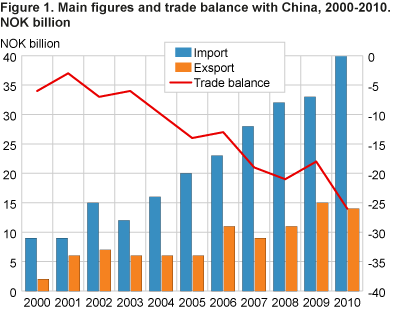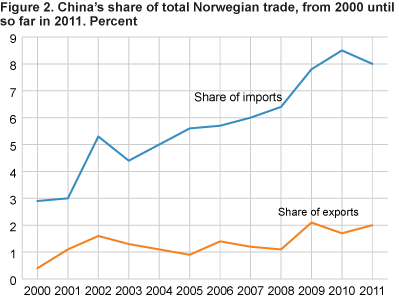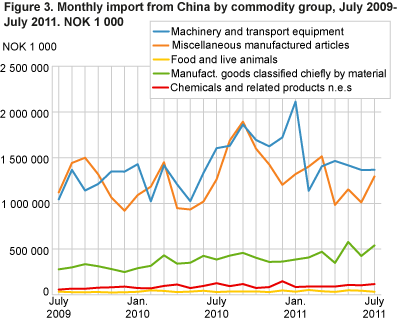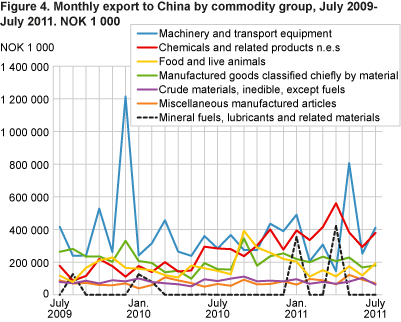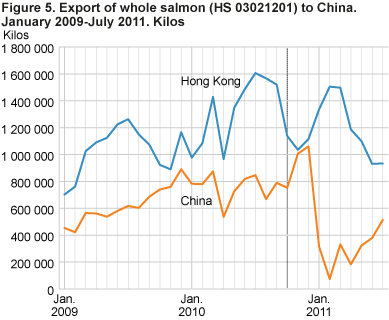Export and import from China
No Nobel effect yet
Published:
Norwegian trade with China increased in the first half of 2011 compared to last year. Excluding fish, few Norwegian export commodities have so far experienced a clear decline since the 2010 Nobel peace prize was awarded to the Chinese dissident Liu Xiaobo.
Over the last 20 years, China has become the whole world’s factory and a significant economical player. While many large economies are presently struggling, China has continually shown high growth rates and solid economic progress - so substantial, in fact, that the government aims to dampen growth in order to avoid high inflation. One of the measures has been to increase interest rates.
The gross domestic product (GDP) in China in 2010 was NOK 61 000 billion according to CIA World Factbook, making it the second largest single economy in the world after the USA. Adjusted for purchasing power and inhabitants, the country ranks 125th largest on a list where Norway came 7th. China became the world’s largest commodity exporter the same year, as they exported for over NOK 9 500 billion. Chinese imports amounted to around NOK 8 400 billion in 2010. In comparison, the equivalent Norwegian figures were NOK 800 billion for exports and NOK 500 billion for imports. China’s largest trade partners were Japan, Korea and the USA. The most traded commodities were the groups electrical and mechanical machines, clothes and mineral oil products, all according to figures from UN Comtrade.
Nobel prize and political trouble
Liu Xiaobo was awarded the Nobel peace prize in October 2010. The news was not given a very positive welcome in China, and the political relationship has since been somewhat strenuous. Threats of trade boycotts followed, negotiations towards a free trade agreement have been put on hold and China has stopped Norwegian salmon at their borders. However, is it possible to see signs of trouble in the foreign trade data that can indicate a so-called Nobel effect, i.e. a decrease in trade as a result of the award?
Increasing trade deficit against China
Both imports and exports to China have grown steadily for the last 10 years. The magnitude of and increase in imports is considerably greater than for exports. Consequently, the Norwegian trade deficit against China has been ever increasing. We imported for almost three times as much as we exported for in 2010, when import values approached NOK 40 billion for the first time.
Further, the Chinese share of total trade in the same time period confirms that this Asian country has become more important. The effects are mostly visible for imports, where China’s share of total Norwegian trade values went from under 3 per cent in the year 2000 to 8.5 per cent in 2010. The share of exports in this period only increased from 0.4 per cent to 1.7 per cent in 2010. It is thus possible to claim that Norway is not particularly vulnerable to a trade boycott, at least not on the aggregated level for exports.
Half year results for 2011 show that imports from China increased by around 16 per cent compared to the first part of 2010, totalling NOK 19.8 billion. At the same time, exports grew by 43 per cent, to NOK 8.5 billion, indicating that growth is continuing well into the year.
What do we trade with China?
Imports are dominated by the commodity groups machinery and transport equipment, together with miscellaneous manufactured articles. The largest components of the first group are computers and mobile phones, while clothes and accessories head the latter category. Large variations in imports from month to month make it hard to unilaterally conclude in favour of a downward turning trend for individual commodity groups following October 2010.
The commodity composition for exports is much more varied than for imports. It is not always as clear which groups are the largest at a given time, since trade varies greatly on a monthly basis. The highest values so far this year were found in the groups chemicals and related products, followed by machinery and transport equipment and then manufactured products. All in all, the trade developments for the first part of 2011 were positive compared to the corresponding period in 2010.
Price developments to Norway’s advantage
Norway reaps benefits both in terms of the price and commodity composition dimensions of the trade with China. Typical Norwegian export products are generally raw materials that have seen considerable price increases, while we import manufactured products at declining prices. A case in point is the import of clothes and accessories, which for 2010 was at index point 88.3 against the reference year 2000 (value = 100) and import prices for computers, which hit an all time low at 31.3 the same year. In contrast, export prices for non-ferrous metals have increased by 5.9 points since year 2000, while fish prices have similarly gone up by 19.4 index points since 2010. Commodity quality is assumed to have risen in the period, indicating that the money spent is providing even more worth.
Turbulence for fish exports
According to the Food and Agriculture Organization of the United Nations (FAO), Norway’s share of the Chinese fish market has grown in the last couple of years. However, after the Nobel prize was awarded a clear decline in Norwegian salmon exports to mainland China was seen. From exporting over 1 million kg of whole salmon in December 2010, the volume fell to around 315 000 kg in January 2011, and further to 75 000 kg in February. The decline cannot be attributed to normal seasonal cycles. In parallel, shipments to Hong Kong grew, so salmon might have been re-directed here initially, although volumes have now stabilised a bit. A slight increase in export volumes to China was observed in the spring but the level is still very low. Part of the loss in exports has been filled by fish from fish farms owned by Norwegian companies in other countries, e.g. Scotland, making the loss of income potentially lower than what can be assumed based solely on these figures. Nevertheless, it is evident that the fish farming industry has been hit hard, and is still dealing with the after effects. Many people will probably claim that this is a direct consequence of the Nobel prize.
Invulnerable imports, particularly for clothes
The trend in Norwegian imports from China is clear and expanding over time. Since 2000, when we imported for a mere NOK 9 billion, imports have increased by close to NOK 31 billion. The important commodity group clothes and accessories grew by over 11 per cent compared to the first half year of 2010, totalling NOK 3.1 billion for January-June 2011. July figures are also positive, with an increase of NOK 48.2 million from July last year. There is therefore nothing to suggest a diminishing of Chinese willingness to trade in clothes, or import commodities in general.
Which overall effect has the Nobel prize had?
On the aggregated trade level no immediate effects of the Nobel prize have been observed, as both imports and exports have increased in the first seven months of the year. The influence of already established long-term contracts is however unknown, and no finite conclusions about the real effect can be drawn before a considerably longer time period has passed. Some commodity groups have been hit, although the direct causality is impossible to establish. Geographically, it is conceivable that the commodities could be redirected through Hong Kong but no unusual spikes in trade have been witnessed, except for the aforementioned case of fish exports.
Contact
-
Statistics Norway's Information Centre

